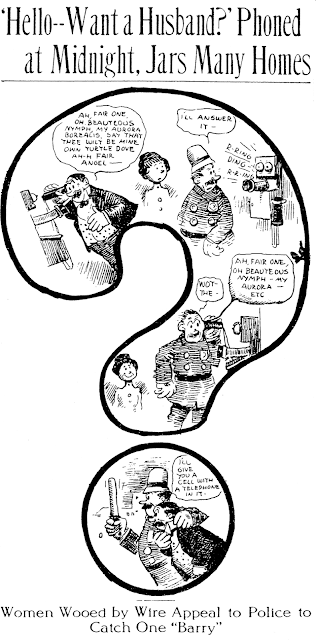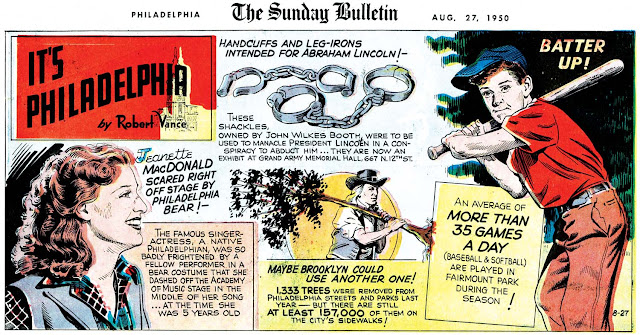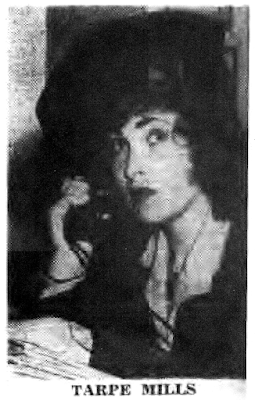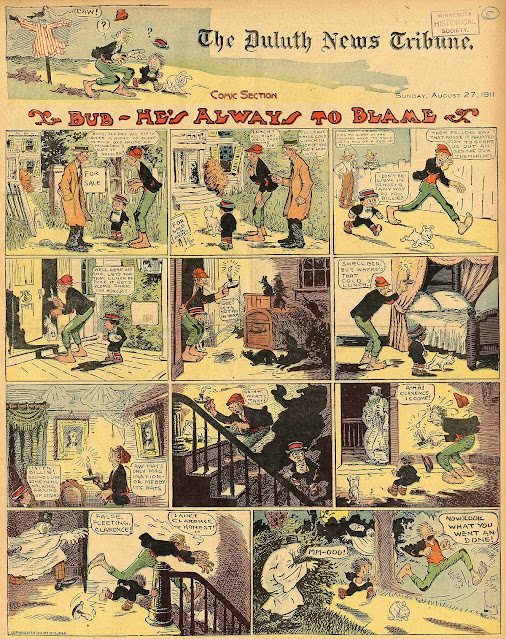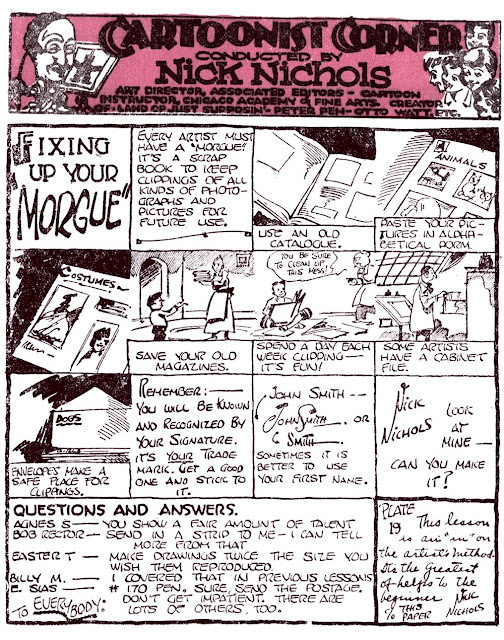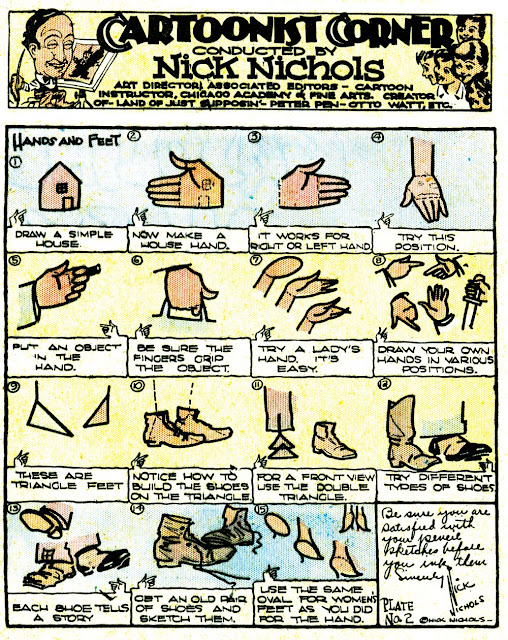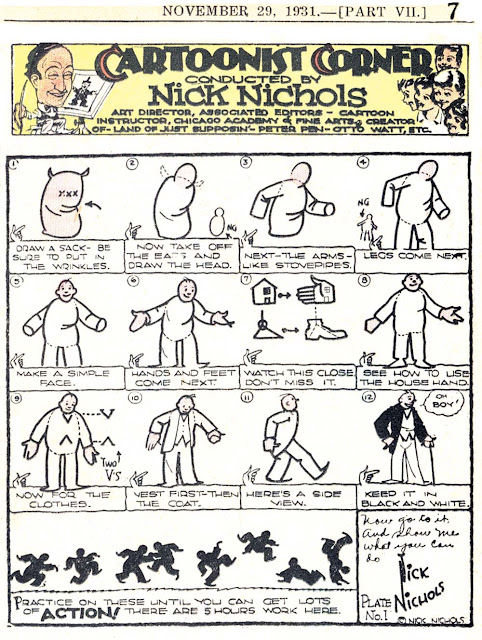Saturday, March 12, 2022
Herriman Saturday: March 22 1910
March 22 1910 -- In what must surely be one of the earliest incidents of crank calling ever, some fellow by the name of Barry has been calling up women all over Los Angeles, claiming to be an admirer from afar. When not hung up on immediately, Barry pitches woo like Christy Mathewson throws fastballs.
The police are on the case now, but with little evidence to work from Barry seems all but untraceable.
Labels: Herriman's LA Examiner Cartoons
Friday, March 11, 2022
Obscurity of the Day: It's Philadelphia
State and local history features have often met with a modicum of success, but you don't find many of them offered space in the Sunday color comics sections. One that did was It's Philadelphia, created by Robert Vance for the Sunday Philadelphia Bulletin.
I know next to nothing about Mr. Vance, but he certainly could draw well, and his ability to dig up interesting and unusual items about his city week after week is impressive. A feature like this about Philly could easily devolve into dry history lessons about Ben Franklin and the Revolutionary War, but Vance consistently mixes up his factoids to keep things quite the box of chocolates for the curious.
The feature began on September 14 1947, initially sporting the unwieldy, not to mention a little bewildering, title of You Never Can Tell ... But It's Philadelphia. Some smart editor wasn't long in taking the red pencil to that, and the title was soon reduced to the far more pithy It's Philadelphia.
The feature ran for an impressive seven years, after which either Vance or the Bulletin decided to call it quits. The last installment ran on October 24 1954.
The one piece of biographical data I have on Vance is that on May 5 1955 he put a revolver to his head and ended his life. His wife seemed unsurprised, saying to a reporter from the Philadelphia Inquirer that he had lately been despondent. Whether that was due to the cancellation of his newspaper feature or some other cause is unknown to me.
Thanks to Cole Johnson for the sample scans.
Labels: Obscurities
--Allan
Thursday, March 10, 2022
News of Yore 1943: Tarpe Mills Profiled
Meet the Real Miss Fury-It's All Done With Mirrors
By James Aronson (New York Post, April 6 1943)
Girls, you'll have to get in line. Tarpe Mills, creator of “Miss Fury,” is one of you, and she said today she isn’t letting go of Dan Carey just like that. Recently she wrote one of Dan’s more burning admirers:
“Listen, sister, put your name on the waiting list. I got here first!”
This fair warning is given because last month The New York Post received 533 letters from enthusiastic followers of “Miss Fury,” the colored comic page that appears in the Week-End Edition. A lot of the letters were from girls who thought that Dan Carey, one of the heroes of the strip, was mighty brave and handsome, and if they ever met up with a type like him, well, their hearts would be faint and
fluttery.
Tarpe Mills, Erasmus Hall High graduate, said that she literally stumbled into cartooning. She posed for portrait-painters, photographers and sculptors to pay her way through Pratt Institute. She studied sculpture and was told that she showed promise; but the market for birdbaths was pretty dry, so she went into animated cartooning.
Among other things she created a few cat characters which were used in a series of pictures, and finally, she said, “I was carried out of the joint with a nervous breakdown.” It was back to posing and free-lance drawing.
“Then,” she said, "a foot injury kept me out of circulation and I started a serial called “Daredevil Barry Finn" for one of the children's comic books. I hated to drop Barry, so I went into the business whole hog and turned out such hair-raising thrillers as 'The Purple Zombie,’ ‘Devil's Dust’ and “The Cat Man.’
Miss Mills dropped her first name (she won't say what it was) because it was too feminine.
“It would have been a major let-down to the kids if they found out that the author of such virile and awesome characters was a gal,” she said.
Miss Mills said she writes “Miss Fury” to provide amusement for kids and grown-ups
alike. “Fashions, a hint of romance and human interest for the adults. Fantasy and action for the youngsters.”
She admitted she doesn't know where she got her inspiration except that she was one of those imaginative kids “who hang around the house reading books instead of running around outside playing hop-scotch.”
Who poses for the girl characters in “Miss Fury,” she was asked.
“It's all done with mirrors," she said. “l find it simpler to sketch from a mirror than to hire a model and explain just what the character should be doing."
(thanks to Mark Johnson, who supplied the article)
Labels: News of Yore
Wednesday, March 09, 2022
Obscurity of the Day: Bub -- He's Always to Blame
The cartoonists who formed the core of the McClure Syndicate bullpen each had one or two bread-and-butter strips in addition to penning short series and one-offs. For Everrett E. Lowry, those honours went to Bub -- He's Always to Blame, which ran in the section starting January 22 1905* and through his taking leave of the syndicate in 1912.
The strip was a pretty staid effort in which we have a couple of rustic kids, Bub and Billie; Bub being the shrimpy one. The tall gangly Billie is the troublemaker of the duo, while Bub, as the title promises, always takes the rap in the end. Since the denouement of each episode is never in doubt, the fun value can only be found in the action that precedes it. Lowry had a pretty good imagination for interesting plots, so the strip was usually worth reading, but I find the characters themselves rather flat. When Lowry was fiven a full page in which to work (as above) his strips were much better than the half-pagers, which have no choice but to rush to that same old tired gag. Add to that Lowry's seeming inability to organize his word balloons properly (is this really so hard, Ev?) and the strip is eminently forgettable.
I don't believe Lowry was overly attached to this strip; I think it was more the syndicate editor who drove that seven year run.The editor proved his belief in the value of the strip in 1912. Lowry's last episode of the strip ran on June 2 1912**, and rather than that being its swan song, it continued appearing uninterrupted. The strips through August 4 appear to be the work of whoever was ghosting Sambo and his Funny Noises at this time, though on Bub they showed their disdain for the task by seemingly drawing it blindfolded. Then it was taken over by Art Bowen, who would not take credit on the strip until the episode of September 22. During that uncredited part of his run, though, he was spelled one time with an unsigned strip by Fred Leipziger on September 8.
Bowen had just recently arrived at the syndicate, and so he was a natural receptacle for the thankless task of continuing Bub -- He's Always to Blame. Bowen brought nothing to the party, unless you count that he turned Billie into an even skinnier beanpole who now looked a LOT like Slim Jim/Circus Solly. Bowen's lackluster work on Bub made it obvious he wasn't thrilled to do the strip. He smartly offered McClure a new strip, What Happens to the Herrings, in hopes of getting off of Bub patrol. Although his new strip was basically a copy of Doings of the Van Loons, a daily strip offering of McClure at this time, it seems to have pleased the powers that be well enough that his sentence on Lowry's old strip was finally commuted. The last episode of Bub -- He's Always to Blame ran on February 2 1913***.
Thanks to Cole Johnson for the samples.
* Source: Chicago Inter-Ocean
** Source: All later dates from San Francisco Chronicle
*** McClure would rerun a few episodes to fill gaps in their February 28 1915 and January 16 1916 comics sections.
Labels: Obscurities
Monday, March 07, 2022
Obscurity of the Day: Cartoonist Corner
Nick Nichols was the creator of several obscure newspaper series, of which Adventures of Peter Pen was the best and longest running; but today we're going to cover his most obscure obscurity, a how-to-draw feature called Cartoonist Corner. (We normally shun activity features, but a special dispensation is granted to those teaching the art of cartooning.)
Cartoonist Corner, unfortunately, is one of the least successful cartooning instruction features I've ever seen. Nichols was obviously in love with the well-worn chalk talk gimmick of drawing one object and then transforming it into another, and mistook this for a valid form of drawing instruction. I've seen that sort of thing done elsewhere, but rarely on such an impressively baroque level. Hey kids, if you can draw a flour bag, then just add a head, arms and legs around it, you can draw a man! And if you like that exercise, draw a house, erase most of it, and then draw fingers and a thumb on it, and you mysteriously and amazingly have a hand! Okay, to be fair, in the very short life of Cartoonist Corner Nichols did offer one lesson with actual useful information (top sample) -- create a swipe file/morgue, and come up with a LEGIBLE signature. Words to live by!
Cartoonist Corner was offered by Associated Editors, of which Nichols was (as he notes in the masthead) the art director. The feature was offered as one of their weekly kids' page offerings, and ran from November 29 1931 to May 1 1932. The samples above, from the Los Angeles Times, had spot colour added by the newspaper -- I don't think Associated Editors had colour in mind for the feature.
Labels: Obscurities
The one about hands and feet, well, at least he suggests using real life references in the end. The double triangle for front view of the feet is, as the previous commenter said, the same as using circles for sketches, but that 'house hand' definitely feels like a crutch.
Third one is the worst on this front, this just sounds like straight up bad advice lol
Sunday, March 06, 2022
Wish You Were Here, from J.R. Williams
An Out Our Way cartoon by J.R. Williams graces this postcard issued by Standley-May, coded as Series 1 W590. I had never heard of vinegarroons, though they are supposedly native to Florida where I lived for many years. Seeing what these creatures look like, I'm very happy never to have had the pleasure of one's acquaintance.
Perhaps even more stomach-churning, though, is the life cycle of the heel fly.
Labels: Wish You Were Here
